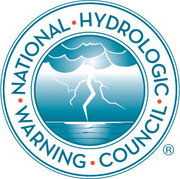
|
MAY 6, 2011
HMT results to be highlighted at upcoming National Hydrologic Warning Council Conference
Keynote speakers include:
- Mary M. Glackin, Undersecretary for Operations, National Oceanic and Atmospheric Administration, who will address forecasts and warnings in the information age;
- Michael Gabaldon, Director of Technical Services, US Bureau of Reclamation, who will discuss the Bureau's latest activities in flood management; and
- Christopher Dunn, Director, Hydrologic Engineering Center, US Army Corps of Engineers, presents a vision for a nationwide water management system and discusses its importance.
Two major results from HMT will be highlighted at this conference:
- The Luncheon presentation on May 12 will be an overview of the ARkStorm Emergency Preparedness Scenario for California – "what happens in California when the next 'Big One' happens," given by Dr. Martin Ralph, NOAA Earth System Research Laboratory. When the USGS' "Multihazards" team considered what to do as a follow-on exercise to their highly successful Southern California Shakeout earthquake project, they chose to explore vulnerabilities to a major winter storm. Based heavily on findings from HMT-West about the importance of atmospheric rivers for flooding in the region, the ARkStorm winter-storm scenario began taking shape and has greatly enhanced awareness of flood and storm risks in California. In 2010 the USGS released the ARkStorm, a hypothetical, though scientifically plausible, California storm scenario. The ARkStorm scenario showed that a series of severe California winter storm could realistically flood thousands of square miles of urban and agricultural land, result in thousands of landslides, disrupt lifelines throughout the state for days or weeks, and cost on the order of $725 billion. This amount is more than three times the costs expected from the magnitude 7.8 ShakeOut scenario earthquake that has roughly the same probability of occurring in any given year as an ARkStorm-like storm sequence. The $725 billion figure comprises approximately $400 billion in immediate property damages and $325 billion in recovery-stage business-interruption losses. An event like the ARkStorm could require the evacuation of as many as 1,500,000 people. Because the flood depths in some areas could realistically be on the order of 10-20 ft, without effective evacuation there could be substantial loss of life. For more information see http://urbanearth.gps.caltech.edu/winter-storm/.
- Dr. Michael Dettinger, of the US Geological Survey and Scripps Institution of Oceanography (SIO), will consider projected changes in the probabilities of occurrence of atmospheric-river storms and floods, and will present highlights of a major new network of hydrometeorological observations being installed in California as part of a 5-year project between the California Department of Water Resources, ESRL's Physical Sciences Division and SIO. The network is designed to monitor key conditions associated with extreme precipitation and flood events and draws heavily upon HMT-West results and methods. Observations in the new State-scale network include continuous snow levels aloft, water vapor aloft (vertically integrated), soil moisture, and horizontal water vapor transport aloft. These data, along with specialized model products, are provided online to reservoir managers, the public and to NWS forecast offices. This network of sensors at over 90 sites across the state will provide modern monitoring of atmospheric rivers and related conditions that represent the primary causes of flooding in this region.
For more information, see the NHWC press release about the conference.
-----------------------------------------
Contacts: Marty Ralph (marty.ralph@noaa.gov), Mike Dettinger (mddettin@usgs.gov)